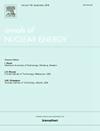Machine learning-based intelligent models for accurate prediction of key parameters in pressurized water reactors with operational data
IF 1.9
3区 工程技术
Q1 NUCLEAR SCIENCE & TECHNOLOGY
引用次数: 0
Abstract
In this research, a quick and accurate prediction model has been developed for the key parameters of pressurized water reactors (PWRs) by applying the residual module neural network and single-channel convolutional neural network. The improved Gen-II PWRs, including CNP1000 and CPR1000, constitute the principal operating units in China and have accumulated a great many measurement values for critical boron concentration (CBC) and power distributions. To improve the prediction accuracy of these key parameters, this study utilizes approximately 19,971 sets of measurement values for CBC and 618 sets of data for 3-D power distribution. These datasets are combined with core state parameters provided by the PWR-core analysis code LOCUST/SPARK, which include factors such as fuel-assembly loading, assembly-averaged burnup, and poison-isotope distribution, among others, to train the intelligent models. As a result the intelligent model linking simulated core state parameters to measured key parameters has been established, making it possible to accurately and rapidly predict the measured CBC and power distribution. The verification tests indicate that the predicted CBCs have an average error of about 3.32 ppm with a 95 % confidence interval of [-6.0 ppm, 7.5 ppm], taking only 1.8 ms for each prediction. The predicted axial-power distributions and axial offset (AO) have an average relative error of about 0.46 % and 0.069 %, with 95 % confidence intervals of [-1.4 %, 1.4 %] and [-0.124 %, 0.071 %], respectively, and require only 8.3 ms for each prediction. Additionally, the predicted radial core power distributions have an average error of about 0.31 % with a 95 % confidence interval of [-0.92 %, 0.92 %] and require only 3.2 ms for each prediction. These results demonstrate that the intelligent models established in this research are capable of predicting key parameters with high accuracy and efficiency, which provides a novel technical approach for further enhancing the operational economy and safety of PWR nuclear power plants.
基于机器学习的基于运行数据的压水堆关键参数准确预测的智能模型
本研究应用残差模块神经网络和单通道卷积神经网络,建立了压水堆关键参数的快速准确预测模型。改进后的Gen-II压水堆,包括CNP1000和CPR1000,是中国的主要运行机组,积累了大量临界硼浓度(CBC)和功率分布的测量值。为了提高这些关键参数的预测精度,本研究使用了大约19,971组CBC测量值和618组三维功率分布数据。这些数据集与pwr堆芯分析代码LOCUST/SPARK提供的堆芯状态参数相结合,其中包括燃料组件负载、组件平均燃耗和毒物同位素分布等因素,以训练智能模型。建立了将模拟的堆芯状态参数与实测关键参数相连接的智能模型,实现了对实测CBC和功率分布的准确、快速预测。验证试验表明,预测CBCs的平均误差约为3.32 ppm, 95%置信区间为[-6.0 ppm, 7.5 ppm],每次预测仅需1.8 ms。预测的轴向功率分布和轴向偏移(AO)的平均相对误差分别为0.46%和0.069%,95%的置信区间分别为[- 1.4%,1.4%]和[- 0.124%,0.071%],每次预测仅需8.3 ms。此外,预测径向堆芯功率分布的平均误差约为0.31%,95%的置信区间为[- 0.92%,0.92%],每次预测仅需3.2 ms。研究结果表明,所建立的智能模型能够高精度、高效地预测关键参数,为进一步提高压水堆核电站的运行经济性和安全性提供了新的技术途径。
本文章由计算机程序翻译,如有差异,请以英文原文为准。
求助全文
约1分钟内获得全文
求助全文
来源期刊

Annals of Nuclear Energy
工程技术-核科学技术
CiteScore
4.30
自引率
21.10%
发文量
632
审稿时长
7.3 months
期刊介绍:
Annals of Nuclear Energy provides an international medium for the communication of original research, ideas and developments in all areas of the field of nuclear energy science and technology. Its scope embraces nuclear fuel reserves, fuel cycles and cost, materials, processing, system and component technology (fission only), design and optimization, direct conversion of nuclear energy sources, environmental control, reactor physics, heat transfer and fluid dynamics, structural analysis, fuel management, future developments, nuclear fuel and safety, nuclear aerosol, neutron physics, computer technology (both software and hardware), risk assessment, radioactive waste disposal and reactor thermal hydraulics. Papers submitted to Annals need to demonstrate a clear link to nuclear power generation/nuclear engineering. Papers which deal with pure nuclear physics, pure health physics, imaging, or attenuation and shielding properties of concretes and various geological materials are not within the scope of the journal. Also, papers that deal with policy or economics are not within the scope of the journal.
 求助内容:
求助内容: 应助结果提醒方式:
应助结果提醒方式:


